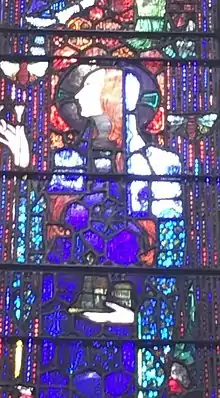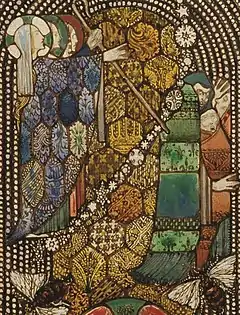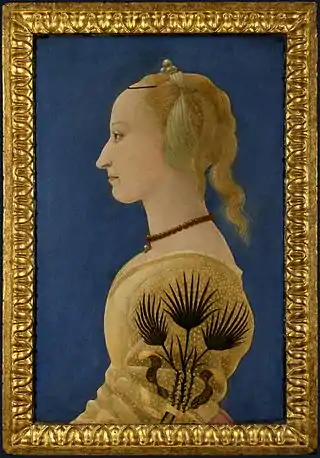Saint Gobnait (Clarke)
The Saint Gobnait stained glass window was designed in 1915[1] and installed in 1916 in the Honan Chapel, Cork by the Irish artist Harry Clarke. It is one of eleven windows he designed for the chapel at the beginning of his career. The commission, and this window in particular, sealed his reputation as an artist of international renown.

Gobnait is shown in half profile, wearing an elaborate royal blue robe, a silver cloak and an extensive veil. The borders of the central glass panel are lined with blue and magenta coloured beads.[2] The background of the window contains honeycomb-shaped lozenges.
Background

Gobnait was born in County Clare but moved for a time the island of Inisheer, where she founded a church. Clarke visited the island often in the 1900s and later honeymooned there. According to the art historian Patricia Rogers, Clarke "certainly would have seen the famous ruins of Gobnet's first church on Inisheer, and these may have attracted him to the subject of this saint."[4] Gobnait became a healer and established a convent in Ballyvourney, County Cork.[4]
The design and building of the Honan Chapel was overseen by John O'Connell, a leading member of the Celtic revival and Arts and Crafts movements.[5] O'Connell sought to construct a chapel that was evoked the aesthetic style found in Ireland and Britain between the 7th and 12th centuries[6] and was "designed and fashioned on the same lines and on the same plan as those which their forefathers had built for their priests and missioners all over Ireland nearly a thousand years ago."[7] According to art critic Kelly Sullivan, the window succeeds in presenting "a particularly Irish idiom of natural imagery".[8]
Clarke and his assistant Kathleen Quigly completed the window's modello under considerable time pressure over five weeks in 1914, during the offer period for the Honan commission and when Clark was still a largely unknown artist. A monochrome study was made in pencil, pen, inks, and watercolour on board, before the cartoon, now at the Corning Museum of Glass, was transferred to glass, when each panel was cut up, waxed and painted.[3] The final window is the largest in the Honan. This was an expensive process, and was funded both by this father, and his friend Augtin Malloy.[9]
Description

St. Gobnait is shown in profile with a pale, thin and ascetic face and is given individualistic, unmistakable features. She wears royal blue and purple robes adorned with lozenged jewels, a veil and silver cloak.[10][11] The window's borders are lined with beaded decorations in ruby and blue.[4] Her clothing draws from Léon Bakst's costume for Ida Rubinstein's 1911 performance of "Le Martyre de saint Sébastien".[12] Highly detailed and complex floral patterns run along the outer borders of each of the window's registers.[13]
Gobnait is known as the patron saint of bees,[4] and she is shown with bees hovering around her face, with a honeycomb at her feet, along with bees chase the thieves said by legend to have raided her church.[14] In this story she unleashed bees against her attackers; Clarke shows "giant bees and tiny figures of frightened robbers peering out anxiously behind the blue-robed saint, whose pointed, impassive profile, unnaturally long slim hands and geometrically stylised body give her an otherworldly, non-human appearance".[15]
In the upper panel, the victims of a plague fled to her for sanctuary and protection. The image shows her drawing the sign of the cross on the road and marking a line around her church with her crosier. According to O'Connell, the line represents the point beyond which "the infection did not come, so that none of those who lived and served with her suffered from the plague."[16]
Influences

Clarke admired Gustav Klimt, whose influence can be seen in the central panel's flatness. According to Michael J. O'Kelly, Clarke's evokes "three-dimensional human expression" using only Gobnait's face and hands, while all other details, including her robes and the floral background, are two dimensional and flat.[13]
The pose of her outstretched right arm draws from both Beardsley and Alesso Baldovinetti's c. 1465 Portrait of a Lady in Yellow. The similarity to Baldovinetti's portrait is especially apparent in her tightly pulled-back hair, high forehead and the profile of her nose.[17] (Gobnait is described in early accounts as a "sharp-beaked nun, and according to writer Frank McNally, Clarke gives her nose "the trajectory of an Olympic ski-jump".)[18]
Reception
The window was described by the art historian Virginia Teehan as "kaleidoscopically sumptuous" and "filled with a wealth of art historical allusions, often unexpected".[12] According to the Irish novelist E. Œ. Somerville, it conjures late 19th century decadence in its resemblance to an Aubrey Beardsley–type female face, which "though horrible [is] so modern and conventionally unconventional ... [Clarke's] windows have a kind of hellish splendour."
In 1917, Seán Keating produced a modernist oil on canvas painting titled "Thinking Out Gobneh", which shows Clarke working on a design for the window.[3][19]
References
Notes
- Teehan & Heckett 2005, p. 169.
- "St. Gobnait". harryclarke.net. Retrieved 2 August 2020
- Rogers 1997, p. 207.
- Rogers 1997, p. 209.
- O'Callaghan 2016, p. 164.
- Sheehy 1980, pp. 163, 164.
- J.J.H. 1916, p. 613.
- Walker, Tom. "Harry Clarke’s uncanny visions of Ireland". Apollo, 29 May 2019. Retrieved 2 August 2020
- Teehan & Heckett 2005, p. 173.
- O'Kelly 1950, p. 294.
- Costigan, Lucy. "St. Gobnait". harryclarke.net. Retrieved 27 March 2020
- Teehan & Heckett 2005, p. 181.
- Sullivan 2018, p. 111.
- O’Riordan 2016.
- Walker 2019.
- O'Connell 1916, p. 53.
- Wilson 2018, p. 19.
- McNally, Frank (11 February 2017). "Gift of the Gob – An Irishman's Diary about the name Gobnait". Irish Times. Retrieved 15 August 2020.
- Gibbons 2018, p. 332–333.
Sources
- Gibbons, Luke (2018). "Afterword: 'Cloistral Silverviened', Harry Clarke and the Intensely Modern". In Griffith, Angela; Kennedy, Róisín; Helmers, Marguerite (eds.). Harry Clarke and Artistic Visions of the New Irish State. Irish Academic Press. ISBN 978-1-7885-5045-1.
- J.J.H. (1916). "Reviewed Work: The Honan Hostel Chapel, Cork. Some Notes on the Building and the Ideals which inspired it by John R. O'Connell". Studies: An Irish Quarterly Review. Franciscan Province of Ireland. 5 (20). JSTOR 25701079.
- O'Callaghan, Antóin (2016). The Churches of Cork City. Dublin: The History Press Ireland. ISBN 978-1-845-88893-0.
- O'Connell, John (1916). The Honan Hostel Chapel Cork: Some Notes on the Building and the Ideas which Inspired It. Cork: Guy & Company.
- O'Kelly, Micheal J. (1950). "The Honan Chapel". The Furrow. 1 (6). JSTOR 27655609.
- O’Riordan, Mary (2016). "St Gobnait - the patron saint of bees and beekeeping". Irish Examiner. Retrieved 8 August 2020.
- Rogers, Patricia (1997). "Bees and Butterflies: Two Drawings by Harry Clarke". Journal of Glass Studies. 39. JSTOR 24190174.
- Sheehy, Jeanne (1980). The Rediscovery of Ireland's Past: Celtic Revival, 1830-1930. Thames & Hudson. ISBN 978-0-5000-1221-5.
- Sullivan, Kelly (2018). "Harry Clarke's Natural world". In Griffith, Angela; Kennedy, Róisín; Helmers, Marguerite (eds.). Harry Clarke and Artistic Visions of the New Irish State. Irish Academic Press. ISBN 978-1-7885-5045-1.
- Teehan, Virginia; Heckett, Elizabeth (2005). The Honan Chapel: A Golden Vision. Cork: Cork University Press. ISBN 978-1-8591-8346-5.
- Walker, Tom (2019). "Harry Clarke's uncanny visions of Ireland". Apollo. Retrieved 9 August 2020.
- Wilson, Ann (2018). "Early Twentieth Century Irish Catholic Devotional Imagery: The Honan Chapel Windows". In Griffith, Angela; Kennedy, Róisín; Helmers, Marguerite (eds.). Harry Clarke and Artistic Visions of the New Irish State. Irish Academic Press. ISBN 978-1-7885-5045-1.
- Wyard, Chris (2015). "Review: Harry Clarke lecture by Dr Nicola Gordon Bowe" (PDF). British Society of Master Glass Painters.
External links
- "Honan Collection Online". Archived from the original on 29 January 2019.